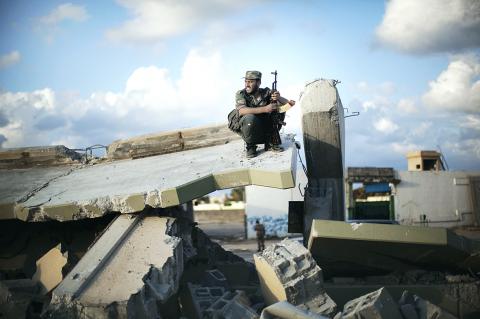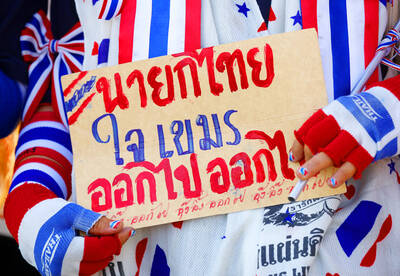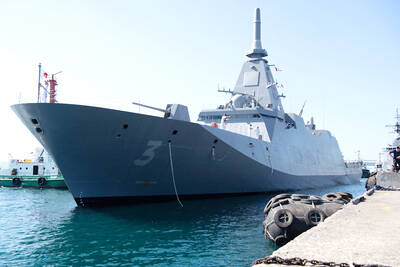Libyan revolutionary forces bulldozed the green walls surrounding former Libyan leader Muammar Qaddafi’s main Tripoli compound, saying it was time “to tear down this symbol of tyranny.”
The sprawling, fortress-like compound known as Bab al-Aziziya has long been hated by Libyans who feared to even walk nearby during Qaddafi’s more than four decades in power and its capture was seen as a turning point in the civil war as revolutionaries overran the capital in late August.
Ahmad Ghargory, commander of a revolutionary brigade, said on Sunday that the area will be turned into a public park accessible to all Libyans.

Photo: AFP
“It’s the revolutionary decision to tear down this symbol of tyranny,” Ghargory said. “We were busy with the war, but now we have the space to do this.”
Already, the courtyard in front of Qaddafi’s former house, which he used for many fiery speeches trying to rally supporters during the uprising, has been turned into a weekly pet market. Tripoli residents roam the premises as if at a museum, with vendors selling revolutionary flags and other souvenirs.
Libyans are eager to move on after decades of repression, even though fighting persists on two fronts and tensions between supporters of the former regime and revolutionary forces remain high — even in Tripoli. The continued instability has delayed efforts by the transitional leadership to move forward with efforts to hold elections and establish democracy.
The Bab al-Aziziya compound, surrounded by high walls lined with barbed wire, had been a mystery to most Libyans though it is one of the city’s largest landmarks. Many Tripoli residents said they would not go near it, fearing security guards on the compound’s high green walls would get suspicious and arrest or shoot them.
The compound was a main target for NATO airstrikes during the months leading to Qaddafi’s ouster in late August.
Fighters forced their way into the area on Aug. 23 during the battle for the capital, jubilantly rampaging through the remnants of barracks, personal living quarters and offices seen as the most defining symbol of Qaddafi’s nearly 42-year rule.
Qaddafi’s residence, now gutted and covered with graffiti, was also targeted in a US bombing raid in April 1986, after Washington held Libya responsible for a blast at a Berlin disco that killed two US servicemen. A sculpture of a clenched fist crushing a US fighter jet that had been erected after the strike has been removed.
Qaddafi entertained guests in a Bedouin-style tent pitched near two tennis courts about 200m from the family home.
Revolutionary forces have squeezed Qaddafi loyalists into one main district in his hometown of Sirte after weeks of fighting, but some said fears of friendly fire as well as a lack of coordination and communications were slowing their advance. Fighters from the eastern city of Benghazi and Misrata to the west were trying to reorganize themselves to solve that problem.
“We have them cornered in a 900 by 700m area, but the fighting is difficult because we are worried about firing on our own forces, they are mixed together,” Benghazi field commander Khaled al-Magrabi said on Sunday.
Commanders said they have agreed to divide the remaining loyalist area between them to prevent confusion.
Libyan fighters also faced discord over the looting of buildings, including the airport and houses in Sirte, on the coast 250m southeast of Tripoli. Trucks were seen carting off tractors, industrial generators and heavy machinery on the road from Sirte to nearby Misrata, which was under siege by Qaddafi forces for months and saw some of the fiercest fighting of the war.

Eleven people, including a former minister, were arrested in Serbia on Friday over a train station disaster in which 16 people died. The concrete canopy of the newly renovated station in the northern city of Novi Sad collapsed on Nov. 1, 2024 in a disaster widely blamed on corruption and poor oversight. It sparked a wave of student-led protests and led to the resignation of then-Serbian prime minister Milos Vucevic and the fall of his government. The public prosecutor’s office in Novi Sad opened an investigation into the accident and deaths. In February, the public prosecutor’s office for organized crime opened another probe into

RISING RACISM: A Japanese group called on China to assure safety in the country, while the Chinese embassy in Tokyo urged action against a ‘surge in xenophobia’ A Japanese woman living in China was attacked and injured by a man in a subway station in Suzhou, China, Japanese media said, hours after two Chinese men were seriously injured in violence in Tokyo. The attacks on Thursday raised concern about xenophobic sentiment in China and Japan that have been blamed for assaults in both countries. It was the third attack involving Japanese living in China since last year. In the two previous cases in China, Chinese authorities have insisted they were isolated incidents. Japanese broadcaster NHK did not identify the woman injured in Suzhou by name, but, citing the Japanese

YELLOW SHIRTS: Many protesters were associated with pro-royalist groups that had previously supported the ouster of Paetongtarn’s father, Thaksin, in 2006 Protesters rallied on Saturday in the Thai capital to demand the resignation of court-suspended Thai Prime Minister Paetongtarn Shinawatra and in support of the armed forces following a violent border dispute with Cambodia that killed more than three dozen people and displaced more than 260,000. Gathered at Bangkok’s Victory Monument despite soaring temperatures, many sang patriotic songs and listened to speeches denouncing Paetongtarn and her father, former Thai prime minister Thaksin Shinawatra, and voiced their backing of the country’s army, which has always retained substantial power in the Southeast Asian country. Police said there were about 2,000 protesters by mid-afternoon, although

MOGAMI-CLASS FRIGATES: The deal is a ‘big step toward elevating national security cooperation with Australia, which is our special strategic partner,’ a Japanese official said Australia is to upgrade its navy with 11 Mogami-class frigates built by Japan’s Mitsubishi Heavy Industries, Australian Minister for Defence Richard Marles said yesterday. Billed as Japan’s biggest defense export deal since World War II, Australia is to pay US$6 billion over the next 10 years to acquire the fleet of stealth frigates. Australia is in the midst of a major military restructure, bolstering its navy with long-range firepower in an effort to deter China. It is striving to expand its fleet of major warships from 11 to 26 over the next decade. “This is clearly the biggest defense-industry agreement that has ever